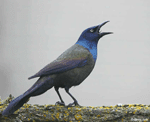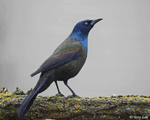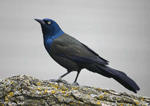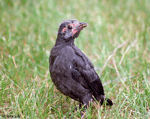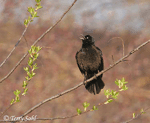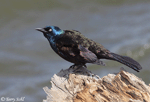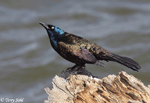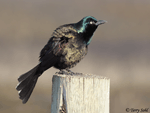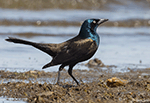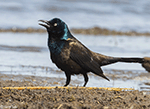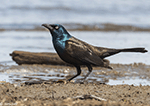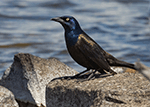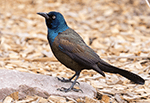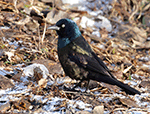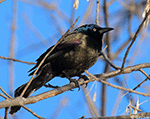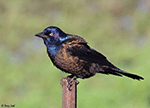| Length: 11 to 13 inches | Wingspan: 17 to 19 inches | Seasonality: Summer / All Seasons |
| ID Keys: Pale yellow eyes, bronze body with dark bluish head, slightly iridescent sheen | ||
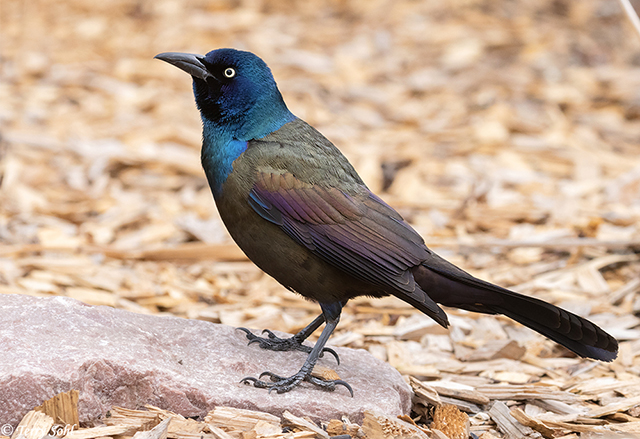 A very common summer
resident, often found in residential areas, the Common Grackle can often be
heard singing its harsh, grating song from treetops and roofs. They often
nest in small colonies, and can form huge mixed flocks with other blackbirds in
the fall and winter. They are the smallest of the three Grackle
species found in the U.S. The larger
Great-tailed Grackle is found in the
Great Plains and the southwestern U.S. and has recently expanded their range
into South Dakota, while the larger
Boat-tailed Grackle is found near the Gulf and Atlantic coasts and is not
found in South Dakota.
A very common summer
resident, often found in residential areas, the Common Grackle can often be
heard singing its harsh, grating song from treetops and roofs. They often
nest in small colonies, and can form huge mixed flocks with other blackbirds in
the fall and winter. They are the smallest of the three Grackle
species found in the U.S. The larger
Great-tailed Grackle is found in the
Great Plains and the southwestern U.S. and has recently expanded their range
into South Dakota, while the larger
Boat-tailed Grackle is found near the Gulf and Atlantic coasts and is not
found in South Dakota.
Habitat:
Farmland, towns, woodlands, marshes, shelterbelts. Prefers dense tree cover next to open spaces for nesting.
Diet:
Omnivorous. Eats seeds, waste grain, fruits and berries, insects, crustaceans, earthworms, frogs, and small rodents. They will also raid nests for eggs and young birds.
Behavior:
Does a great deal of foraging by walking along the ground. Will also forage low in bushes, forest undergrowth, and sometimes higher in the forest canopy. Gregarious, often foraging in large flocks outside of the breeding season.
Nesting:
May through July in South Dakota. Common Grackles typically nest in relatively small, loose colonies. The nest is a cup of grasses, weeds and twigs, placed in the branches of a dense tree or shrub, or sometimes in a tree cavity or cavity in a man-made structure. The female lays 4 or 5 eggs, and she alone incubates them. Upon hatching, both parents feed the young. The young leave the nest after about 15 to 20 days.
Song:
Common Grackles have a highly variable repertoire, with a variety of squeaks, rattles, and croaking sounds.
- Click here to hear the various calls and "songs" of a Common Grackle1
- Click here to hear the shorter, typical call notes of a Common Grackle2
Migration:
Winters in southeastern U.S., but may overwinter in southern parts of the state.
Interactive eBird Map:
Click here for an interactive eBird map of Common Grackle sightings
Similar Species:
Similar to some other grackle species, and could potentially be confused with some blackbird species if not seen well.
- Great-tailed Grackle - Great-tailed Grackles are primarily a species of the southern and southwestern US (and points south), but their range has increased in recent decades, and they've increasingly been sighted in South Dakota. Both will sometimes utilize similar habitat in cattail marshes and wetlands, so there is a possibility of both species being present in an area. Similar in overall plumage, the obvious difference is the extremely large, more rounded tail of the Great-tailed Grackle. Common Grackles also tend to have a more strong demarcation between plumage colors and iridescence on the head and neck, versus the rest of the body, while the color is more consistent on a Great-tailed Grackle. Females bewteen the two species are more similar and difficult to differentiate. Female Great-tailed Grackles lack the massive tail of the male, and structurally look similar to Common Grackles. However, female Great-tailed Grackles generally have lighter plumage on the head and underparts, while female Common Grackles are more uniformly dark.
- Boat-tailed Grackle - Not an ID problem in South Dakota, as Boat-tailed Grackles are found near the coastlines of the eastern and southeastern US. Where they overlap in range, as with the Great-tailed Grackle, the primary ID key is the extremely large tail on the male. Females are are also lighter on the head, neck, and underparts than the more uniformly dark Common Grackle.
- Brewer's Blackbird - Not a grackle species, but they do overlap in range with Common Grackles and share similar plumage patterns. Brewer's Blackbirds are smaller than Common Grackles, with a less robust bill and a shorter tail.
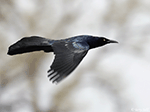 |
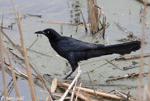 |
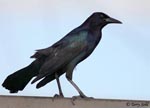 |
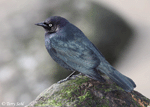 |
| Great-tailed Grackle | Great-tailed Grackle | Boat-tailed Grackle | Brewer's Blackbird |
Bird Feeders:
Will attend feeders for various seeds, bread crumbs, and suet.
Conservation Status:
Generally common and widespread in many areas, with a broad geographic range. However, records in recent decades have shown sharp declines (although the rate of decline has slowed considerably recently). Populations are still strong however, and the species is under no serious threat at this time. The IUCN lists the Common Grackle as a species of "Least Concern".
Further Information:
Photo Information:
May 2nd, 2020 -- Brandon, South Dakota -- Terry Sohl
Additional Photos:
Click on the image chips or text links below for additional, higher-resolution Common Grackle photos.
Audio File Credits:
- 1Richard E. Webster. Recorded in Saskatchewan on June 8th, 2014. Original recording and information from xeno-canto.
- 2Paul Marvin. Recorded in Brevard County, Florida on April 1st, 2018. Original recording and information from xeno-canto.
| Click on the map below for a higher-resolution view |
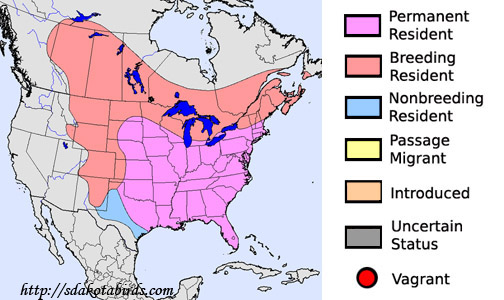 |
| South Dakota Status: Common summer resident throughout the state. Rare in winter, primarily in the southeastern part of the state. |
Additional Common Grackle Photos
Click for a higher-resolution version of these photos
